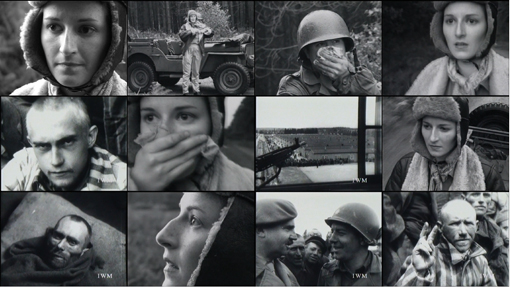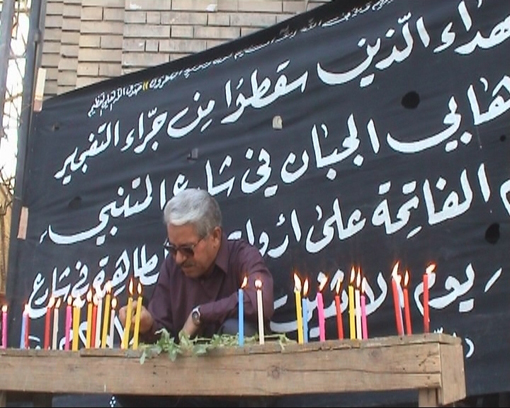The Imperial War Museum’s Student Film Festival, to be renamed the 'IWM Short Film Festival', will return in 2014 after the IWM's closure for major refurbishment. Toby Haggith, Senior Curator in the Department of Research at the Museum, provides a guided tour of its history and celebrates the festival's first decade of activity.
 About the Author: Toby Haggith is a historian who joined the Imperial War Museum’s Film Department in 1988. He has a PhD in Social History from the University of Warwick and has published various essays on film and history. In 2000 he became head of non-commercial access to the film and video collection and responsible for devising the daily Public Film Show programme. In 2001, he started the IWM Student Film Festival (now the IWM Short Film Festival) and was closely involved in the creation and recording of the musical tracks on the Museum’s DVD release of the digitally restored 1916 film, The Battle of the Somme. He is now a Senior Curator in the Department of Research and is currently leading the Museum’s project to restore and complete the British concentration camp documentary, retrospectively titled, Memory of the Camps.
About the Author: Toby Haggith is a historian who joined the Imperial War Museum’s Film Department in 1988. He has a PhD in Social History from the University of Warwick and has published various essays on film and history. In 2000 he became head of non-commercial access to the film and video collection and responsible for devising the daily Public Film Show programme. In 2001, he started the IWM Student Film Festival (now the IWM Short Film Festival) and was closely involved in the creation and recording of the musical tracks on the Museum’s DVD release of the digitally restored 1916 film, The Battle of the Somme. He is now a Senior Curator in the Department of Research and is currently leading the Museum’s project to restore and complete the British concentration camp documentary, retrospectively titled, Memory of the Camps.
… the Museum has often been critical of the way that its footage has been misused in television programmes
Origins The Imperial War Museum was set up in the wake of the First World War as a memorial to the sacrifice and effort of that great conflict. In a particularly far-sighted initiative by the Museum’s first curator and trustees, it was decided that film should be among the categories of record and artefact that would be collected and preserved to memorialise and document the war. The Museum’s moving image collection became the world’s first film archive and by some fifteen years the oldest in the UK. Despite its pedigree and the size of the holdings (it now holds over 20,000 hours of film and video tape), the Museum’s moving image collection is still relatively little known beyond a small community of scholars and professional film researchers.

The Ghost of Morris Horn, winner of the 2010 'Best Imaginative Response to the Subject of War'.
Since 1999 I have been the person mainly responsible for devising the Public Film Show programme and have also tried to use these screenings as a way of supporting the curatorial work of the Archive and to promote some of its aims. It was while thinking of ways that we might use the cinema programme to promote a more responsible and sensitive use of IWM archive footage in historical documentaries that I viewed Breaking Home Ties (1999), a short film sent in by Matthew Strong that he made while studying for a BA in Graphic Design and Film at Buckingham Chilterns University. I was bowled over by the imaginative way he used archival images to tell the story of his father’s experience of National Service during the 1956 Suez Crisis. It occurred to me that there must be many such films and videos produced by students as part of their course work but which were probably only ever shown publicly a handful of times and that potentially they deserved a much wider audience. At the IWM my colleague Matthew Lee and myself had already long been facilitating the production of such student films by providing access to IWM footage and arranging the telecine of selected clips at preferential rates. If we could provide a public showcase for these short films and videos, could we not also begin to engage aspiring young filmmakers in some of the issues that concerned us as well as making them aware of the riches of the Museum’s collection? In short, the Festival could not only contribute to the professional training of young film and television producers but also create greater awareness of the Museum’s film archive among the general public.
How the Festival Works The Festival is open to any student or amateur filmmaker who has made a film or video that incorporates archive footage from the Museum’s collection or that has been made in response to its exhibitions or collections. Each title in the Festival is also entered into the competition for which there are three categories: the Annie Dodds Award for the Best Documentary (sponsored by October Films), the Best Imaginative Response to the Subject of War (sponsored by Prime Focus), and the Winner of the Audience Poll. An important feature of the Festival is the audience ballot, with each member of the audience being given the opportunity to express their opinion of the films they have seen. Until the tenth Festival we always pre-announced the winning titles before the awards ceremony, but in 2010/11 however we bowed to the reality-game show culture and announced the winners at the awards ceremony itself.
… Festival films have often uncovered stories that have been overlooked by the British mainstream media
Ten years of the Festival – highlights and anecdotes Since its inaugural year, the Festival has grown and developed into an important and recognised showcase for young filmmaking talent. Many of the students whose films have won prizes in the Festival have gone on to successful careers in the film and television industry, including at least two that were recruited directly by the Festival's competition sponsors. One of those is Genevieve Simms, and we are particularly proud of the way the Festival recognised and helped to foster that talent. As a prizewinner, she was afforded some post-production facilities by the History Channel, our principal sponsor, and was thus able to re-record and edit the film. With the confidence gained from this recognition of her talents she made another film, which she submitted the following year and Liberating Dachau (2006) went on to win the Audience Poll for the sixth Festival. Genevieve’s story is important as it highlights the value of our stated criteria for the selection of winners:

Liberating Dachau, winner of the Audience Poll in 2006.
Production values, while important, are not the primary concern of the judges, imagination, sensitivity to the subject matter, and a coherent use of historical source material is more likely to impress the panel. For this reason, filmmakers submitting films using fairly basic equipment should not fear that their efforts will be overlooked when shown alongside pieces made using broadcast-quality kit.
In addition to discovering talent in non-traditional areas, Festival films have often uncovered stories that have been overlooked by the British mainstream media. These include the experiences of Italian soldiers during the Second World; the story of a Korean who served in the Japanese army during the Second World War; the perilous journey of Vietnamese refugees to the UK; the internment of Italians, German and Jewish civilians in Britain from 1939; women Home Guard auxiliaries, and a number of films on the experiences of Indian and African-Americans soldiers and pilots during the Second World War. Due to the dearth of professionally made films about Black and Asian history, I have selected Festival films such as Sohail Rahman’s documentary Nagin (1991) about his father’s war service in the Indian Air Force and The Other American Invasion (2001), a documentary about African-American servicemen in Britain during the Second World War for inclusion in the annual Public Film Show programme run to coincide with Black History Month. The relevance and quality of numerous other student Festival films has led to their inclusion in other Public programmes on themes such as landscape, film and memory, animation and the work of women artists.
Soldiers of a Lesser Blood (2008), Pervez Akhter’ s film about the Indian Army during the Second World War, was based on interviews with veterans, speaking in their own language, and now living in Pakistan. Although Pervez’ s film did not win, the judges recognised its potential and the rarity of such a perspective for British audiences. As a result there were discussions about how the film could be developed, and Pervez is now part of a team led by Dave Green and John Digance, tutors at the Documentary School at the University of Bedfordshire, collaborating with us on a major documentary project based on interviews with former members of the Indian Army now living in India, Pakistan and Britai
Looking at some 150 films screened during the last ten years of the Festival, there has been an understandable interest in the two World Wars but there has also been a refreshing range of topics and many of these highly contemporary ones. Along with films on the Falklands War, Vietnam, the experience of refugees and immigration, the Holocaust, the former Yugoslavia, the Troubles in Northern Ireland, other themes covered include war gaming and historical re-enactment. In addition, as a film is eligible for submission if it includes archive film from the Museum’s collection, we have also had entries, even winners, with no military content: these include films on astronomy, the British lido and bread.

A Candle for the Shabandar Café, winner of the 'Annie Dodds Award' for the Best Documentary in 2010.
One of the unforeseen benefits of opening up the Festival to amateur filmmakers has been the submission of films from serving members of the armed forces. For the tenth Festival, this led to the intriguing situation of a film made by a British Territorial soldier, Martin Carey, about a comrade’s experiences during the opening phase of the invasion of Iraq (Memories of Iraq, 2010), being shown alongside five films made by students of the Independent Film and Television College in Baghdad, all of which included reflections of the impact of the American and British-led invasion on Iraqi society.
Early in the history of the Festival National Film School student Julie Speechley enquired if we would be willing to accept her film Fields (2002), as it was ‘anti-war’. We assured her we would and indeed we re-wrote the text on entry criteria to ensure that filmmakers would not be discouraged from submitting films on this topic. In fact, there has always been a robust strand of directly anti-war films as well as many films which satirise aspects not just of military history but the collections and even the curators at the Museum (!). Animation students at the Royal College of Art for the last three years have submitted the results of the Lipsynch Workshop, which create cartoon embodiments of voices recorded in interviews held in the Museum’s Sound Archive. As well as the fascinating ways they have created representations of the voices of people such as Lord Haw Haw/William Joyce, the young animators have made hysterical cartoon representations of the Museum’s curator- interviewers.
Audience and attendances and reactions The Festival is also popular with the Museum’s visitors, with some religiously coming to every Festival and ensuring that they attend each programme, so that they can express their preferences through the audience ballot. 07-25 (2010), Angus Boulton’s beautifully shot film of Typhoons at RAF Coningsby, scored five smiley faces with one member of our audience, who also added: ‘I like planes’. While another person suggested that Hassanain al Hani’s documentary A Stranger in His Own Country, about a Shi’i refugee who sells coffee in the streets of Baghdad was, ‘Perhaps not for the Imperial War Museum. London’ – although this critic still awarded three smiley faces. We have come across many such comments scribbled on the ballot slips over the years. Perhaps we should formalise this kind of engagement, by inviting a member of the public on to the judges’ panel? The trenchant and forthright comments sometimes scrawled on the voting slips or passed on to the Museum Assistants who work in the cinema during the screenings, also reflect another aim of the Festival - which has been to challenge our audiences with films they might not expect to see at the Museum, both in terms of content and style. So for example, many of the films we have screened made by visual artists were really designed for gallery screenings or as part of installations. One of the earliest example of this genre, and one of my favourites, was This is War (2002), in which video artist Greg Meeson, daubed head to foot in green, with rifle in hand, adopted the poses of a plastic moulded toy soldier, atop a ‘plastic base’. In the most recent Festival 07-25 and Listening to See (2010), by artist Alan Hampson, are good examples of the valuable contribution that artists have made to the Festival.
The Future The IWM Short Film Festival is due to return in 2014.
Toby Haggith
IWM Film Festival - contacts Matthew Lee IWM North, The Quays, Trafford Wharf Road, Manchester, M17 1TZ E-mail: mlee@iwm.org.uk Tel: 0161 836 4028 Web: www.iwm.org.uk